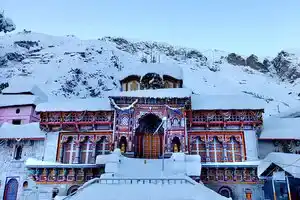History of Badrinath
Home » Badrinath Dham »
The precise origins of the sacred temple remain unknown due to the absence of concrete historical records. However, the presiding deity, Lord Vishnu has found mention in numerous Vedic scriptures, which date back between 1750 and 500 BC. Some historians believe that the temple was originally a Buddhist shrine, based on its former architectural feature which was a typical style in Buddhist Viharas. This was the reason why Badrinath Temple remained under Buddhist influence until the 8th century. It is also believed that the establishment of the current temple was done under reformer Adi Shankaracharya.Another origin theory states that Adi Shankaracharya after the establishment, resided there from 814 to 820 AD and discovered an image of Lord Badrinath in the pristine waters of the holy Alaknanda River, beside which the temple is situated.

Restoration and Natural Calamities
Badrinath Temple has experienced many natural calamities over the years. The 1803 Himalayan earthquake did the most harm to the temple, which led to a rebuilding effort overseen by the King of Jaipur. More renovations began in the late 1870s and ended just after World War I.
Literary and Mythological Mentions:
Though not specifically mentioned in the four Vedas, Badrinath is majorly featured in the scriptures written post-Vedic eras such as Puranas, Bhagavad Gita, and Mahabharata.
Let’s have a look at what major scriptures state:
- Skanda Purana: The Skanda Purana states: "There are many holy places on Earth, in heaven and the netherworld, but none is equal to Badrinath."
- Bhagavad Gita: The Bhagavad Gita has it that Lord Vishnu previously mediated here in his Nar-Narayan form for the good of the world.
- Padma Purana: The Padma Purana says "This is the region where the saints have meditated in a state of pure devotion, where the power of their energy and penance is high.” This place is a hub for divine connection where the spiritual, cosmic energy is at its peak.
Badrinath, formerly called Badrikashram, was a hub for sages and ascetics who were on a journey to seek spiritual enlightenment.
Winter Abode: Joshimath
Joshimath also popularly known as Jyotirmath, is where the idol of Lord Badrinath is ceremoniously transported to Joshimath (Jyotirmath), a holy town located at 1,890 meters above sea level, owing to a considerable amount of snow and extremely bad weather. Since the main temple is closed from November to April, Joshimath is considered the deity’s winter home, as well as a place to start treks and Himalayan expeditions.
Interesting Facts About Badrinath Temple
Have a look at some interesting facts that highlight the spiritual significance of Badrinath:
- Lord Vishnu’s 2nd Vaikuntha (celestial home): Badrinath is considered the second celestial abode of Lord Vishnu after Kshir Sagar, as mentioned in Hindu texts and mythology.
- Akhand Jyoti (The Eternal Flame): Even when the temple is shut during winter, a sacred lamp known as Akhand Jyoti continues to burn inside, symbolizing divine presence throughout the year.
- Prophecy of Narasimha Temple: It is a common belief that when the arms of the idol present in the Narasimha temple in Joshimath break, then both the Nar and Narayan peaks will collapse and merge into each other. This will end all connections of Badrinath with the material world.
- One of the 108 Divya Desams: Badrinath is one of 108 Divya Desams; holy Vishnu temples mentioned by the Alwar saints. This adds to the prominence of Badrinath not only in the Vaishnavite tradition but also as a significant destination in the Char Dham Yatra.
Conclusion
Badrinath Temple is not only a sacred temple but a hub of mythology, history, and spirituality. From its mysterious origins and connections with Adi Shankaracharya, the great sage who revived it, to its sacred status within Hindu texts, it seems every stone of Badrinath is part of a sacred story itself. Whether you visit Badrinath during the summer pilgrimage or pay homage to it in the silence of its winter residence, the temple remains an eternal hub for devotion and faith to worshippers worldwide.


Leave a Reply